Regular security audits, the use of strong passwords and multi-factor authentication, the upkeep of software, staff training, the use of security frameworks, data backups, and network monitoring are all advised. Cybersecurity is a continuous process that needs constant evaluation and development.
The Internet needs cyber security. This is because most cyber attacks are automated and aim to exploit common vulnerabilities rather than specific websites or organizations. The goal of cyber security is to prevent computer systems from being accessed unauthorizedly or otherwise damaged or rendered unusable. The concept of information security encompasses the protection of all forms of information, whether they are digital or hardcopy.
The practice of cybersecurity involves protecting critical systems and sensitive information from digital attacks. Cybersecurity measures referred to as information technology security (IT security), are designed to counter threats against networked systems and applications, whether from within or outside an organization.
Because SCADA (supervisory control and data acquisition) systems sometimes rely on outdated software, critical infrastructure firms are frequently more susceptible to attack than other organizations. The NIS Regulations apply to those who operate vital services in the UK's energy, transportation, health, and water sectors as well as those that supply digital services.
Organizations must use the proper organizational and technological controls to manage their security risks in accordance with the Regulations. It can be difficult to stay on top of emerging technology, security trends, and threat information. It is essential to do so in order to safeguard data and other assets from various types of cyberthreats.
Types Of Cyber Threats Include:
Malware is a type of malicious software that enables any kind of program or file to be used on someone who uses a computer. Worms, viruses, Trojans, and spyware are a few examples of different kinds of software.
Ransomware is another type of malware that involves an attacker locking the victim's computer system files, typically through encryption, and demanding a payment to decrypt and unlock them.
Attacks that rely on interpersonal contact are known as social engineering. In order to obtain sensitive information that is generally safeguarded, it fools users into circumventing security measures.
A form of social engineering called as phishing involves sending fraudulent emails or messages that appear to be from reputable or well-known sources. These communications, which are typically random attacks, are meant to get private data such as login passwords or credit card details.
The spearphishing approach targets a particular person, organization, or enterprise.
Insider risks are defined as security breaches or losses caused by individuals, such as employees, subcontractors, or clients. Insider threats can be nefarious or negligent.






